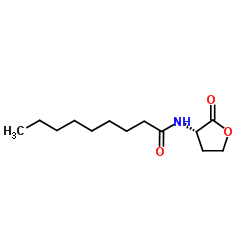177158-21-3
| Name | N-nonanoyl-L-Homoserine lactone |
|---|---|
| Synonyms |
Nonanamide, N-[(3S)-tetrahydro-2-oxo-3-furanyl]-
N-[(3S)-2-Oxotetrahydro-3-furanyl]nonanamide |
| Description | Quorum sensing is a regulatory system used by bacteria to control gene expression in response to increased cell density. This regulatory process manifests itself in a variety of phenotypes, including biofilm formation and virulence factor production. Coordinated gene expression is achieved through the production, release and detection of small diffusible signaling molecules called autoinducers. N-acylated homoserine lactones (AHLs) comprise a class of such autoinducers, each of which generally consists of a fatty acid coupled to a homoserine lactone (HSL). Modulation of bacterial quorum-sensing signaling systems to suppress pathogenesis represents a new approach to antimicrobial therapy for infectious diseases. AHLs differ in acyl length (C4-C18), C3 substitution (hydrogen, hydroxyl, or oxo group), and the presence or absence of one or more carbon-carbon double bonds in the fatty acid chain. These differences confer signaling specificity through the affinity of the LuxR family of transcriptional regulators. C9-HSL is a rare odd-numbered acyl carbon chain produced by wild-type Erwinia carotovora strain SCC 3193 grown in nutrient-rich Luria-Bertani broth (LB) medium. |
|---|---|
| Related Catalog |
| Density | 1.0±0.1 g/cm3 |
|---|---|
| Boiling Point | 456.8±34.0 °C at 760 mmHg |
| Molecular Formula | C13H23NO3 |
| Molecular Weight | 241.327 |
| Flash Point | 230.0±25.7 °C |
| Exact Mass | 241.167801 |
| PSA | 55.40000 |
| LogP | 1.55 |
| Vapour Pressure | 0.0±1.1 mmHg at 25°C |
| Index of Refraction | 1.476 |
